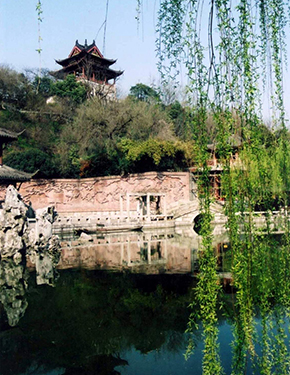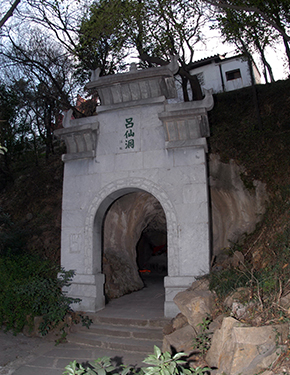
YELLOW CRANE TOWER
- Nomal
- Enlarge
- Reduce
Lying north of Xiangjiang River and east of Bashan Mountains, Wuhan naturally has mind-boggling grandeur. Yangtze River and its longest branch Hanjiang River converge together in this Hubei’s hinterland inhabited by Wuchang, Hanyang and Hankou—three towns of Wuhan. This city amazingly nestles on the Jianghan Plain’s eastern tip abuzz with southern hills, lakes and marshes. Yellow Crane Tower lifts its crest into the sky, overlooking myriad boats on the Yangtze River sandwiched between Snake Mountain and Turtle Mountain. Alas, the tower is a great artwork of Mother Nature.
This masterwork blends classicism and modernism, poetics and aesthetics. At the point of mountain-water interaction, it agrees with our Chinese’s custom of mounting high, our awareness of getting close to nature and our philosophy of revering the universe. So, mounting the tower is a twofold luxury. You not only will enjoy inviting views, but also can experience a transcendental realm, in which mind and universe become one. Finally, the mind will be purified. All this is perhaps why the tower has showed off such a fascinating vibe over the past ages.
This tower stands atop Snake Mountain, Wuchang. Since ancient times, it has been “a great wonder of the world.” Indeed, it is no less famous than Hunan-based Yueyang Tower or Jiangxi-based Teng Prince Pavilion.
The exact building time was the 2nd Year (223) of Eastern Wu, Three Kingdoms Period. Back then, it was a mere “watchtower” at Xiakou City. But later the situation changed after Jin wiped out Eastern Wu and unified China. As local business flourished against this backdrop, watching and guarding gave way to sightseeing. Over time it had blossomed into a must-see spot for anyone coming here, be him an official, a merchant or a tourist. In addition, a banquet could be served hereon at its best. This tower provides a panorama of nearby waters and distant mountains. “The crane, once gone, has never returned; yet the white clouds drift aimlessly over one thousand years. Now the trees of Hanyang are arrayed before the clear river; and fragrant grasses grow lush on Parrot Island.” These lines by Cui Hao create such a thought-provoking realm.
It went through repeated reconstruction and destruction, in Ming Era and Qing Era, for example, the tower got destructed 7 times and reconstructed/renovated 10 times. As a saying goes, “If the nation prospers, the tower would be prosperous too.” In the 10th Year (1884) of Qing’s Guangxu Period, a great fire burnt the tower to stark ashes. But when it came to 1985, a new Yellow Crane Tower stood on the Yangtze riverside.
From its erection onwards, Yellow Crane Tower goes through many contour designs. All such antique designs have their marked features. Unlike the two counterparts in China, this tower adopts a mix of octagon (Ba) and square (Fang), which means “getting access to all eight directions.” Obviously, these figures are part of architectural symbolism. To take a vertical look, each eave-row may resemble a fluttering crane that suggests close ties with the tower’s name. On the whole, this tower boasts majesty as well as meticulosity. There are nuances of beauty worth exploring in depth.

Tourist Service
- consulting hotline
Service hotline: 027-88875096
Supervision hotline: 027-88848188
027-12301
(Wuhan Tourism Bureau.)
027-87124701
(Hubei Tourism Administration)
- Official qr code.

Scan focuses on the yellow crane tower.
- Online consultant
- Complaint and advice






